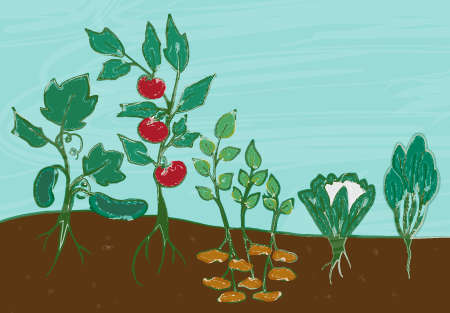
Add color to your dinner plate with these garden starter ideas.
Don’t let fear of failure keep you from trying to garden.
The growing season provides a chance to add a variety of vegetables and color to your dinner plate, so take time to experiment and have fun.
“Gardening success varies from year to year,” said Chrisanne Urban, a Marshfield Clinic registered dietitian. “Putting aside time for watering and nurturing is a good first step to a successful garden.”
5 starter foods
Grow foods you like, Urban said. This can make gardening more exciting and enjoyable.
She suggests five of her gardening favorites as starter ideas:
- Tomatoes are rich in lycopene and antioxidants, which can help prevent cancer.
- Cucumbers usually grow well in Wisconsin, Urban said. And, like most vegetables, they’re low in calories. Just ½ cup of sliced cucumbers is 8 calories.
- Spinach or dark greens have plenty of vitamins A, C and K.
- Cruciferous vegetables include cauliflower, cabbage, garden cress, bok choy, broccoli and brussel sprouts. These are rich in vitamin C and fiber.
- Sweet potatoes provide vitamin A and beta-carotene. “I eat the skin, too, for its good fiber content,” she said.
You can find planting ideas online. The Old Farmer’s Almanac has a planting date calculator and will create a calendar specific to your location.
Check with your doctor before making a change in your diet. Some vegetables, because of their high vitamin content, might not mix well with medications.
The more color, the better
“I like growing tomatoes and sweet potatoes to add color to my diet,” Urban said.
The American Cancer Society highly recommends a colorful diet, stating, “Research shows that the best foods for fighting cancer come in vibrant packages.”
No room for a full garden? Try alternatives
“You don’t have to plant a full garden to be a successful gardener,” she said. “If you don’t have much room, use pots for a patio garden.”
Another option is community gardens. Contact your chamber of commerce or local health organizations to learn if your area has community gardens available for your use.
A final chance to get fresh fruits and vegetables without a garden is to go to farmers markets.
“People don’t always have time to plant gardens and that’s okay,” Urban said. “Most communities have farmers markets with a variety of colorful choices.”
Check to see what’s in season
Plan your produce purchases to catch what’s fresh. These guides from Shine365 can help you choose seasonal produce at your local farmers market.
What’s fresh at the farmers market? (June)
What’s at the farmers market in July and August? (July/August)
What’s at the farmers market in the fall? (fall and end of season)


I am starting my third year of straw bale gardening and have really enjoyed the process and the food. You can put the bales anywhere there is full sun, they give you a raised garden so you are not on your knees all the time, and weeds stay at a minimum. I grow from starter plants and from seed and both have done well. The tomatoes were amazing and this year I expect more of everything because I have moved the bale location to a sunnier spot. Janke's has the book that gives you all the info you need to get started.
Thanks for the tip, Darlene! -Kirstie